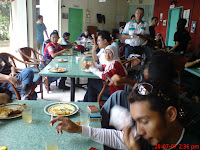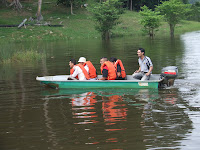Twin-shock, regular swingarmThe classic motorcycle suspension system. An H-shaped swingarm is pivoted at the front to the motorbike frame. On either side there are basic coilover units which provide the suspension. The shocks are inside the coilover units. This is about as basic as you can get on a motorbike and has been around for as long as the motorbike itself. This style of suspension began to fall out of favour in the 80's due to weight considerations and the availability of newer, stronger materials. It was also not a particularly robust design by modern considerations. It all got a bit bendy and flexible under extreme riding conditions, and the only way to make it stronger was to add more metal, which added more unsprung weight, which reduced the efficiency of the suspension. | ![[rear swingarm]](http://www.carbibles.com/watermark.php?image=images/bike_rear_double.jpg) |
![[monoshock]](http://www.carbibles.com/watermark.php?image=images/bike_rear_monoshock1.jpg) | Monoshock, older style, regular swingarmIn 1977, the first monoshock system appeared to niche markets and racers. It has actually been around in one form or another since the 1930's, but it was only in the early 80's that monoshocks started to appear on production bikes. Monoshock is actually a Yamaha trademark, but it has become synonymous with the design in the same way as people in the UK refer to vacuum cleaners as hoovers. (The Honda version is called Pro-Link). The premise was that manufacturers could save some weight by redesigning the rear suspension and removing one of the coilover units. Monoshocks are still coilovers, but there's only one and it's mounted centrally to the swingarm. On earlier models, the rear swingarm was a sort of basket with a linkage at the top-front. The monoshock sat nearly horizontal in the bike. |
Monoshock, newer style, regular swingarm
On the current monoshock designs, there is now a complex linkage at the bottom end which joins the coilover to the swingarm itself, and its important to lube the joints in these linkages regularly. They are very exposed to the elements when riding. The linkage adds leverage to the suspension plus it allows the coilover to be mounted more vertically. Ever in need of less weight (and hence more speed), those clever engineers who devised this variation were able to remove the 'basket' part of the swingarm, and
|
![[single-sided swingarm]](http://www.carbibles.com/watermark.php?image=images/bike_rear_singlesided.jpg) | Monoshock, single-sided swingarmThe ultimate evolution of the monoshock design is the single-sided swingarm. These are super-strong, super-lightweight swingarms like you might find on a VFR800. The advantage of a single-sided system is that the wheel can quickly be taken out and replaced. Not really a huge advantage for you or I fiddling with our bikes at the weekend, but for Moto-GP style racing, it does make a huge difference for the pit crew. Single-sided swingarms need to be pretty heavily engineered because they bear the all the stresses from the rear axle offset to one side. With the traditional double-beam swingarm, the design needs to have longitudinal stiffness to stop it from bending. With the single-sided design, it needs to also have torsional stiffness to stop it from twisting under the offset load. As a result, single-sided swingarms are typically a lot larger and have a huge amount of cross-bracing inside them. |
One shock or two? The frothy subject of frappuccino damper oil.
 In the good old days, motorbikes had two shock absorbers on the rear of the bike, as shown at the top of this section. As suspension evolved, the dual rear shocks were replaced with a single unit, but the question is why? The answer, it turns out, is pretty simple. In a dual-shock system, the suspension units are typically attached very close to the rear axle. This means that as the suspension compresses and expands, the shock absorber pistons are travelling in a stroke which is nearly the same as the full deflection of the swingarm. Hitting a large bump might deflect the rear axle upwards by 10cm and back, resulting in the same 10cm stroke in the shocks. Do this a lot and the shock absorber piston begins to behave like the plunger in one of those natty little cafetières or milk-frothers - it agitates the damper oil so much and so frequently that the oil begins to heat up and foam or froth. At this point it not only looks like frappuccino foam but it has about the same damping properties too, and thus loses its ability to perform as it should. This is known as fading shock absorbers.
In the good old days, motorbikes had two shock absorbers on the rear of the bike, as shown at the top of this section. As suspension evolved, the dual rear shocks were replaced with a single unit, but the question is why? The answer, it turns out, is pretty simple. In a dual-shock system, the suspension units are typically attached very close to the rear axle. This means that as the suspension compresses and expands, the shock absorber pistons are travelling in a stroke which is nearly the same as the full deflection of the swingarm. Hitting a large bump might deflect the rear axle upwards by 10cm and back, resulting in the same 10cm stroke in the shocks. Do this a lot and the shock absorber piston begins to behave like the plunger in one of those natty little cafetières or milk-frothers - it agitates the damper oil so much and so frequently that the oil begins to heat up and foam or froth. At this point it not only looks like frappuccino foam but it has about the same damping properties too, and thus loses its ability to perform as it should. This is known as fading shock absorbers.
Enter the single shock absorber system mounted towards the front of the rear swingarm. The swingarm might still have a lot of travel at the axle, but basic geometry shows you that closer to the pivot, the deflection is much less. This translates into shorter shock absorber movements which in turn means less opportunity for the damper oil to froth. The ultimate evolution of this is the complex link monoshock system (also shown above), where a complex series of levers reduce the shock absorber travel even further. Typically multi-link setups like this also have some amount of variance in them so that they have a different amount of deflection in the first part of the stroke to the that in the second. This means a single shock absorber unit can respond better to changing road surfaces, soaking up the smaller bumps and shocks with ease and comfort without sacrificing the ability to respond to the occasional mountain or pothole.
As a side note, you'll notice as you read the section on BMW rear suspension below that the monolever and first-generation paralever had a single shock but it was mounted close to the rear axle. This had all the disadvantages of a dual-shock system without any of the advantages of a single-shock system. For the second-generation paralever, the shock was moved closer to the swingarm pivot, thus bringing the design in-line with the small-deflection idea.
Rear monolever.In 1980, BMW introduced the world to the monolever suspension system on the back end of their R80GS big dirt bike. Little did anyone know at the time that it was a sign of the radical design changes to come. Most BMW bikes, modern ones anyway, have shaft drive, so its a given on a beemer that one side of the rear suspension is going to be pretty beefy because it has to house the driveshaft and ultimately the rear drive. BMW capitalised on this and with the monolever, they created a single-sided suspension system, much like the Yamaha monoshock, but the shock / strut unit was mounted to one side of the bike, rather than in the centre. The driveshaft ran down the inside of the single-sided swingarm and into the rear drive. This design helped eliminate the need for beefier engineering at the front of the swingarm which would have been needed to resist the torsional load of having the wheel mounted to a single-sided swingarm. | ![[BMW monolever]](http://www.carbibles.com/watermark.php?image=images/bike_bmwmonolever.jpg) |
![[BMW paralever]](http://www.carbibles.com/watermark.php?image=images/bike_bmwparalever1.jpg) | Rear paralever, first generation. In 1987, BMW improved on their design and introduced the paralever suspension system on the back end of the new R100GS, a system which found its way on to their K1 sports bike too. |
Rear paralever, second generation.In 1993, the second generation paralever system appeared on the R1100GS. The basic design was the same as the original paralever except that the strut/shock unit was moved away from the side of the bike and on to the centreline, bringing it more in line with the monoshock type system. It also gained a remote preload adjuster and spring plate height adjuster. This new paralever was made of aluminium instead of steel so it was lighter than the original whilst maintaining the strength needed for the single-sided shaft drive system. | ![[BMW paralever]](http://www.carbibles.com/watermark.php?image=images/bike_bmwparalever2.jpg) |
![[BMW paralever]](http://www.carbibles.com/watermark.php?image=images/bike_bmwparalever3.jpg) | Rear paralever, third generation.Skip forward ten years to 2004 - which tells you how good the paralever II was that its design didn't change in nearly a decade. The third generation paralever appeared in the new R1200GS. This design is similar but at the same time noticably different to its predecessor, and at the time of writing is now the current BMW rear suspension of choice. The control arm was moved above the shaft drive from underneath, and the rear drive was changed to have a hole through the middle of it to save weight. The unsprung weight of the latest generation paralever is considerably lighter than its predecessors. That's not to say that it couldn't still be used as a substantial bludgeoning weapon if you got it off the bike, but in engineering terms, it has slimmed down considerably. |
TQ to www.carbibles.com for sharing this article...





































































































































































